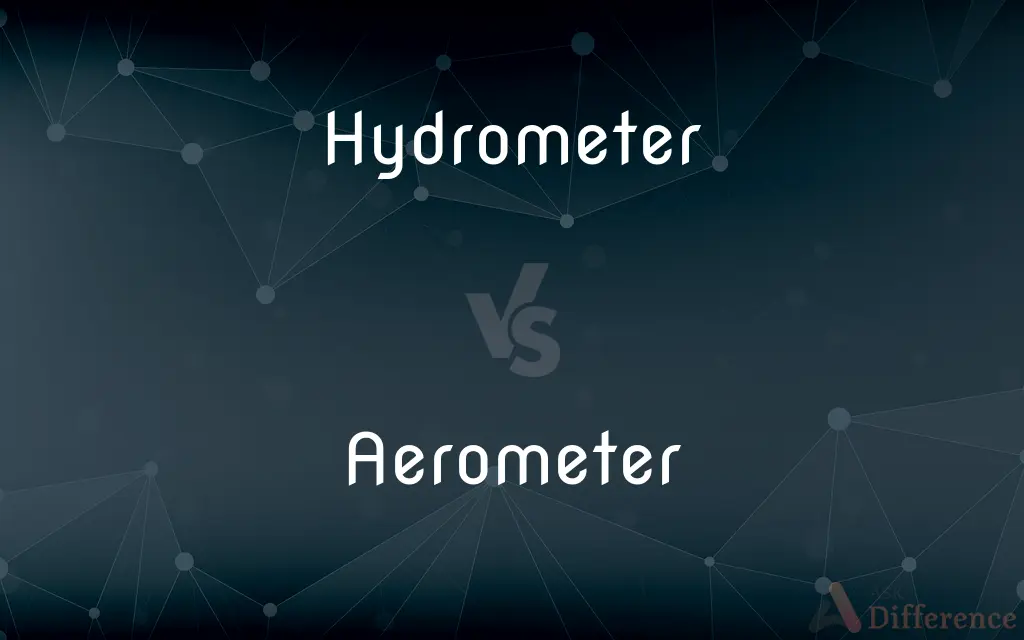Hydrometer vs. Aerometer — What's the Difference?
By Urooj Arif & Maham Liaqat — Updated on March 2, 2024
Hydrometers measure liquid density, whereas aerometers gauge air or gas density.

Difference Between Hydrometer and Aerometer
Table of Contents
ADVERTISEMENT
Key Differences
A hydrometer and an aerometer are both instruments used to measure density, but they are designed for different mediums. A hydrometer is specifically used to determine the density of liquids relative to water. It is commonly utilized in industries such as brewing, winemaking, and in laboratories to measure the specific gravity (SG) of liquids, which can indicate purity, concentration, or potential alcohol content in fermentation processes.
An aerometer, on the other hand, is designed to measure the density of air or gases. While not as commonly referred to in everyday use as hydrometers, aerometers play a crucial role in fields such as meteorology, aviation, and environmental science. They help in assessing air quality, determining atmospheric conditions, and calculating the density altitude for aircraft performance calculations.
The principle of operation differs between the two instruments. A hydrometer floats in the liquid being measured, and its reading is taken from a scale on the stem of the instrument, which correlates to the density of the liquid. The higher the density of the liquid, the less the hydrometer will sink, and vice versa. Aerometers work on a similar principle but are designed to float in or measure the pressure of the gas being analyzed.
Both instruments are critical in their respective fields for ensuring quality control, safety, and the accuracy of various processes and measurements. For instance, a hydrometer can be used to ensure the correct sugar content in a beverage production process, while an aerometer can be essential for measuring air density in environmental monitoring.
Despite their different applications, both hydrometers and aerometers emphasize the importance of accurate density measurements in scientific and industrial contexts. Their use facilitates a deeper understanding of the properties of liquids and gases, respectively, contributing to advancements in technology, science, and industry.
ADVERTISEMENT
Comparison Chart
Measurement Focus
Liquid density
Air or gas density
Common Uses
Brewing, winemaking, laboratory analyses
Meteorology, aviation, environmental science
Principle of Operation
Floats in liquid, reading taken from a scale
Floats in or measures pressure of gas
Importance
Indicates purity, concentration, alcohol content
Assesses air quality, atmospheric conditions
Application Fields
Food and beverage industry, scientific research
Meteorology, aviation, environmental monitoring
Compare with Definitions
Hydrometer
An instrument for measuring the density of liquids relative to water.
The brewer used a hydrometer to check the beer's specific gravity, ensuring the fermentation process was on track.
Aerometer
An instrument designed to measure the density of air or gases.
The meteorologist used an aerometer to determine the air density, which is crucial for weather forecasting.
Hydrometer
A tool for assessing the potential alcohol content in fermentation processes.
The distiller measured the wash's specific gravity with a hydrometer to estimate the potential alcohol yield.
Aerometer
Critical for calculating density altitude in aviation for performance considerations.
Pilots check the aerometer readings to understand how the aircraft will perform under current atmospheric conditions.
Hydrometer
Essential for quality control in industries like brewing and winemaking.
The winemaker regularly used a hydrometer to ensure the wine had the correct sugar levels before bottling.
Aerometer
Plays a role in environmental science by measuring gas densities for air quality assessments.
Environmental scientists use aerometers to monitor pollution levels in the air, contributing to air quality management.
Hydrometer
Utilizes the principle of buoyancy to determine liquid density.
By observing how deep the hydrometer sank in the solution, the chemist could determine its density.
Aerometer
Operates on the principle of buoyancy or pressure measurement in gases.
The aerometer indicated a change in the gas mixture's density, signaling a potential leak.
Hydrometer
Helps in measuring the purity and concentration of solutions in laboratories.
In the lab, the hydrometer's reading helped ascertain the saltwater solution's concentration.
Aerometer
Essential in fields requiring accurate atmospheric condition measurements.
In aviation, accurate aerometer readings are vital for ensuring safe and efficient flight operations.
Hydrometer
A hydrometer is an instrument used for measuring the relative density of liquids based on the concept of buoyancy. They are typically calibrated and graduated with one or more scales such as specific gravity.
Aerometer
An instrument for determining the weight and density of air or another gas.
Hydrometer
An instrument used to determine specific gravity, especially a sealed, graduated tube, weighted at one end, that sinks in a fluid to a depth used as a measure of the fluid's specific gravity.
Aerometer
An instrument used to measure the mass and density of gases.
Hydrometer
An instrument that floats in a liquid and measures its specific gravity on a scale.
Aerometer
An instrument for ascertaining the weight or density of air and gases.
Hydrometer
An instrument for determining the specific gravities of liquids, and thence the strength spirituous liquors, saline solutions, etc.
Hydrometer
An instrument, variously constructed, used for measuring the velocity or discharge of water, as in rivers, from reservoirs, etc., and called by various specific names according to its construction or use, as tachometer, rheometer, hydrometer, pendulum, etc.; a current gauge.
Hydrometer
A measuring instrument for determining the specific gravity of a liquid or solid
Common Curiosities
How do environmental scientists use aerometers?
They use aerometers to assess air quality by measuring the density of different gases in the atmosphere, which can indicate pollution levels.
Is specific gravity the only measurement a hydrometer can provide?
While specific gravity is the most common measurement, hydrometers can be calibrated to measure other related properties, such as alcohol content or sugar concentration, depending on the scale used.
Can aerometers be used to measure the density of any gas?
While aerometers are versatile, their ability to measure different gases may depend on the specific design and calibration of the instrument.
Can a hydrometer be used to measure gas density?
No, a hydrometer is designed specifically for liquids and cannot accurately measure gas density.
Why is air density measurement important in aviation?
Air density affects aircraft performance, including lift, engine power, and propeller efficiency, making accurate measurement critical for safety and efficiency.
How do changes in temperature affect hydrometer and aerometer readings?
Both instruments are temperature-sensitive; their readings can be affected by temperature changes, requiring temperature compensation or calibration for accurate measurements.
How do brewers use hydrometers to determine when fermentation is complete?
By measuring the specific gravity at different stages, brewers can determine when the sugar has been sufficiently converted to alcohol, indicating the end of fermentation.
Are there digital versions of hydrometers and aerometers?
Yes, there are digital versions that offer more precise measurements and easier readability, along with additional features like temperature compensation.
What is the primary difference between a hydrometer and an aerometer?
The primary difference is their application; hydrometers measure liquid density, while aerometers measure the density of air or gases.
What role does a hydrometer play in winemaking?
It measures the sugar content of the grape must before fermentation, allowing winemakers to predict the potential alcohol content of the wine.
How has the technology behind hydrometers and aerometers evolved?
Technology has introduced digital and more sophisticated instruments with improved accuracy, ease of use, and the ability to measure under a wider range of conditions.
Can jumping into conclusions based on a single hydrometer or aerometer reading lead to errors?
Yes, factors like temperature, calibration, and the specific characteristics of the liquid or gas can affect readings, so it's important to consider these and possibly take multiple readings for accuracy.
Are there any safety considerations when using a hydrometer or aerometer?
While generally safe, handling these instruments requires care to avoid breakage, especially if they are made of glass, and to ensure accurate readings, particularly in volatile or pressurized environments.
What is density altitude and why is it important?
Density altitude is the altitude relative to standard atmospheric conditions at which the air density would be equal to the current air density. It's important in aviation because it affects the aircraft's performance, particularly during takeoff and landing.
How does an aerometer measure air density?
It can measure air density directly through buoyancy in a controlled volume of air or gas, or indirectly by measuring pressure and temperature to calculate density.
Share Your Discovery

Previous Comparison
Nun vs. Wimple
Next Comparison
Lumberjack vs. WoodcutterAuthor Spotlight
Written by
Urooj ArifUrooj is a skilled content writer at Ask Difference, known for her exceptional ability to simplify complex topics into engaging and informative content. With a passion for research and a flair for clear, concise writing, she consistently delivers articles that resonate with our diverse audience.
Co-written by
Maham Liaqat














































